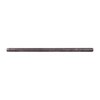All the loving care of the best stock maker and the meticulous attention to detail of the master machinist will not make a gun shoot any straighter than the accuracy capability of the barrel used. And, it is the insides of a barrel, that very small and vital area of lands and grooves over which the gunsmith has no control, that can determine whether the finished work of art is for shooting - or “just for looks”. Craftsmanship . . . not price . . . determines the quality of a barrel. But, by the same token, the customer willing to spend the money for a custom gun is shortsighted indeed, if he starts economizing and orders “just any old barrel so long as it’s cheap”. Furthermore, he is jeopardizing your reputation as a gun builder by making such a request. We, as your supplier, are laying our reputation (and yours, too!) on the line by offering you barrel blanks. They have got to be good or we are in trouble! Big trouble!! We must never sell you anything but that which will enlarge your stature with your trade. And, we feel that the BrownellS Barrel, made for us by Ed Shilen, will do just that! Shilen barrels, either chrome moly or Stainless, are rifled with six lands and grooves by the “Cold Forming” process using carbide dies made in Shilen’s own plan under the most rigid controls. This rifling method achieves extremely close inside uniformity from breech to muzzle. Finished barrels are air-gauge inspected (air-gauged sensitivity is .00005" - five-one-hundred-thousandths!) and 6X borescope in- spected. All barrels, .22 through .30 caliber have groove tolerances within .0005" and uniformity within .0003" No straightening is done, and all barrels are completely stress-relieved. All stainless steel barrels are hand lapped at the factory. Only those barrels passing all spec tests are offered to the trade. Any barrel even slightly “suspect” is started through the production process again and bored to a large caliber. In no other way can quality and reputation be maintained. Slightly more expensive to produce - but vastly greater in quality and ultimate performance.
Scopri la qualità senza compromessi dei nostri canne UNTURNED
Tutta la cura amorevole del miglior produttore di calci e l'attenzione meticolosa ai dettagli del maestro meccanico non possono far sparare un'arma più dritta della capacità di precisione della canna utilizzata. È l'interno di una canna, quella piccola e vitale area di righe e scanalature su cui l'armiere non ha controllo, a determinare se l'opera finita è per il tiro - o “solo per bellezza”. La lavorazione artigianale... non il prezzo... determina la qualità di una canna.
Tuttavia, il cliente disposto a spendere per un'arma personalizzata è davvero miope se inizia a risparmiare e ordina “qualsiasi vecchia canna purché sia economica”. Inoltre, sta mettendo a rischio la tua reputazione come costruttore di armi facendo tale richiesta. Noi, come tuo fornitore, stiamo mettendo in gioco la nostra reputazione (e anche la tua!) offrendo canne grezze. Devono essere di alta qualità, altrimenti siamo nei guai! Grandi guai!! Non dobbiamo mai venderti nulla che non accresca la tua statura nel tuo settore. E crediamo che la canna Brownells, realizzata per noi da Ed Shilen, farà proprio questo!
Caratteristiche delle canne Shilen
- Le canne Shilen, sia in chrome moly che in acciaio inossidabile, sono rigate con sei righe e scanalature attraverso il processo di “Cold Forming” utilizzando matrici in carburo realizzate nel piano di Shilen sotto i controlli più rigidi.
- Questo metodo di rigatura raggiunge un'uniformità interna estremamente ravvicinata dal fondello alla volata.
- Le canne finite sono ispezionate con gauge ad aria (la sensibilità del gauge ad aria è di .00005" - cinque centomila!) e ispezionate con borescope 6X.
- Tutte le canne, da .22 a .30 calibro, hanno tolleranze di scanalatura entro .0005" e uniformità entro .0003".
- Non viene effettuata alcuna rettifica e tutte le canne sono completamente relieve di stress.
- Tutte le canne in acciaio inossidabile sono lucidate a mano in fabbrica.
- Solo quelle canne che superano tutti i test di specifica sono offerte al commercio.
Qualsiasi canna anche solo leggermente “sospetta” viene riavviata nel processo di produzione e forata a un calibro maggiore. In nessun altro modo si può mantenere la qualità e la reputazione. Leggermente più costose da produrre - ma di qualità e prestazioni nettamente superiori.










